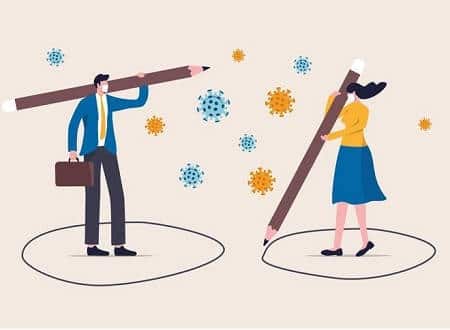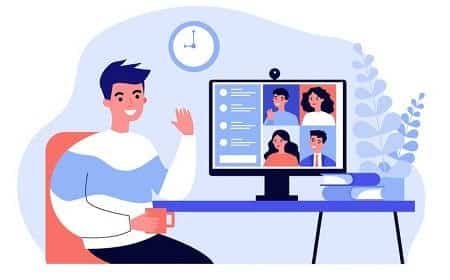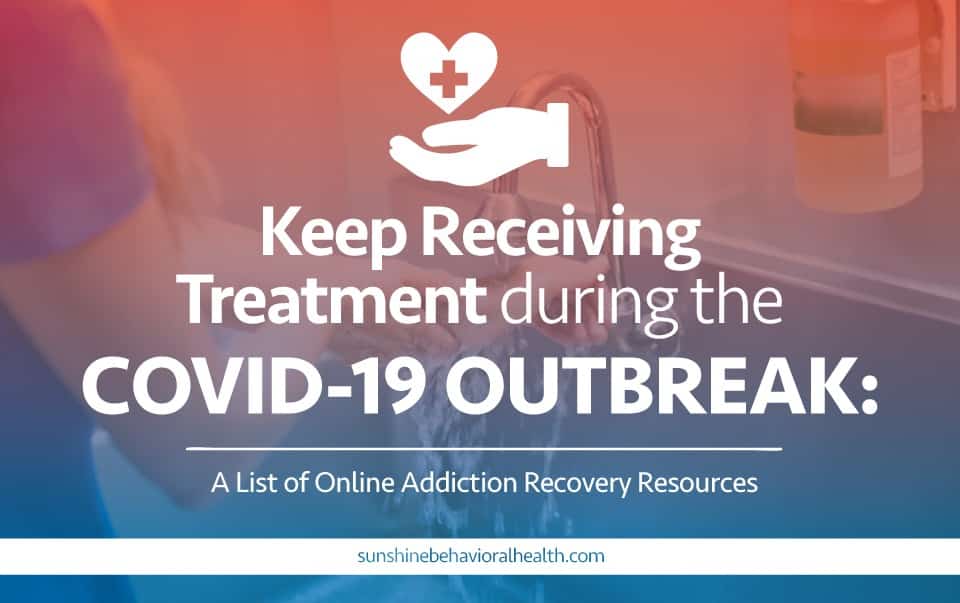Updated March 2021
Since the novel coronavirus emerged in December 2019, prompting stay-at-home orders in some states as early as March 2020, daily life changed for many of us and, as of January 2021, hadn’t fully returned to normal. This includes how we access medical and other healthcare services, including substance use disorder treatment.
When an individual is ready to tackle their substance use disorder (SUD), time is of the essence. Any delay or interruption might derail their ability, willingness, or desire to seek treatment for misuse of alcohol or drugs.
Even after rehab, aftercare services such as therapy and support groups are needed to help prevent relapse.
With in-person consultations limited to the most urgent cases, telehealth has moved to the forefront.
Note: If you or a loved one are battling addiction, we are here for you. Our inpatient rehabs can help you recover from an addiction to meth, heroin, alcohol, cocaine, marijuana, and more. Sunshine Behavioral Health has locations in Texas, Colorado, California and Illinois.
What Is COVID-19?
COVID-19 (SARS-CoV-2) is one of many viruses that cause respiratory illnesses in people, including some forms of the common cold. Although it has similar symptoms to some strains of influenza, COVID-19 is caused by a different type of virus.
COVID stands for coronavirus disease. This novel coronavirus was discovered in Wuhan, China, in December 2019. In four months it had become a pandemic, a worldwide epidemic.
As of Jan. 21, 2020, confirmed cases of COVID-19 worldwide were only 200 with four deaths. Only one US infection was known. By March 29, 2021, almost 128 million COVID-19 cases were reported worldwide, of which almost 2.8 million had died. In the United States, almost 31 million cases were reported by that date with more than 562,000 deaths.
The rate per one million population worldwide was 16,409 cases and 359 deaths. In the US, the rate was 93,155 cases and 1,692, higher than Canada (25,414 and 602) and Mexico (17,136 and 1,552).
With COVID-19 vaccines now coming on the market—by March 26, 2021, three were approved for emergency use in the US, with seven more in Phase 3 clinical trials—the rates are expected to decline, but some precautions may have to remain in place through much of 2021.
Why Can’t People Meet Face-to-Face?
 Those precautions include keeping at least six feet away from anyone outside of your immediate household, wearing a surgical-type mask when it can’t be avoided, and frequently washing your hands for at least 20 seconds.
Those precautions include keeping at least six feet away from anyone outside of your immediate household, wearing a surgical-type mask when it can’t be avoided, and frequently washing your hands for at least 20 seconds.
COVID-19 is airborne. While it is not known exactly how long COVID-19 lingers in the air, it seems to be up to three hours in the air.
It may not be easily transmissible on objects and surfaces, but the virus is detectable for about four hours on copper, 24 hours on cardboard, and three days on plastic and stainless steel
It doesn’t matter if you have no observable symptoms. You can be contagious for at least 48 hours before they occur and for between two and 14 days after exposure (four to five days seems to be average).
No one with a seasonal type of flu should engage in the sort of behavior or contact that social distancing is meant to prevent, either, but the reasons COVID-19 requires more extreme measures are:
- Because COVID-19 is a novel (new) coronavirus, the human body has no natural immunity to it.
- Because COVID-19 seems to be more contagious than the flu. As of March 2021, three mutated variants of COVID-19 were confirmed, at least one of which seems more contagious..
- Because COVID-19 symptoms take longer to show, people may be infecting others before they realize they have it themselves.
- Because although vaccines are starting to roll out, it will be months before they are available to everyone; it’s not known for how long they will be effective or if they prevent infecting others; some people may choose not to take them.
What Is Social Distancing?
While wearing a mask is an effective method to prevent spreading COVID-19, it may not offer as much protection to the wearers as to those around them. To flatten the curve of new cases and avoid overwhelming the health care system, we must also practice social distancing: work from home if possible, stay six feet away from other people, make no unnecessary physical contact, and avoid public places and groups of 10 people or more.
People with symptoms of possible COVID-19 are told to self-isolate so they won’t spread the virus and overwhelm available services needed for emergencies. That includes staying away from doctors’ offices, clinics, and hospitals. Individuals with a substance use disorder (SUD) are usually not considered emergencies unless they are experiencing an overdose.
Rehab centers also want to avoid overcrowding and risking COVID-19 infection. Alcoholics Anonymous and similar groups—famous for welcoming everyone and having meetings almost every day, and often several times a day—are limiting the number who can attend, foregoing the communal snacks offered at many meetings, or canceling face-to-face meetings indefinitely.
Stresses of Social Distancing
Social distancing is making many people feel more isolated. When someone with substance use disorder (SUD) is cut off from support and services, or even the promise of them, they may feel more isolated, mentally as well as physically. That’s when they are most likely to turn to the bottle (booze or pills) or the needle to cope.
According to the U.S. Centers for Disease Control and Prevention (CDC), individuals with mental health conditions, including substance use disorder, are less likely to handle stress well. Their inability to cope may have triggered their SUD in the first place.
They also may have poorer health due to their SUD, which may make them more susceptible and less able to fight off the coronavirus and other health problems.
Without these precautions, it is estimated that as many as 2 million people in the United States could die. According to one simulation model, more than 1 million could still die unless social distancing and other measures continue until a vaccine is available.
Although the vaccines are becoming available more quickly than expected, cases of COVID-19 and deaths were spiking during the winter months when transmission is more likely. Hopes that COVID-19 was seasonal and would go away on its own in the warmer months were not realized, either.
What should a drug-addicted or alcohol-addicted person do in the time of a pandemic such as the COVID-19 novel coronavirus? There may be options as close as your palm, lap, or desktop: telehealth. Many people have relapsed to their old drug use; for example heroin relapse rates have significantly increased or they started using prescribed drugs incorrectly like shooting ativan or starting making their own hotshot drugs.
What Is Telehealth?
Telehealth, also known as telemedicine, is the use of video, audio, and sometimes other remote devices to deliver long-distance clinical health care to people who cannot or should not travel to a doctor’s office, clinic, or hospital. Use of telehealth increased by more than 150% at the end of March 2020 compared to March 2019.
Using two-way interactive communication—smartphone, electronic tablet, or computer—health professionals can speak with, examine, diagnose, and sometimes treat clients at a distance. With the right equipment, a surgeon can perform surgery by remote control.
With telehealth, individuals who can’t get to a doctor can bring the doctor to them electronically via video: ask questions, talk to a therapist, receive prescription medicines or treatments, and receive health news updates and tips.
Though it was mostly used in rural areas where physicians are far away, during the pandemic telehealth has been used to minimize the transmission of COVID-19. Substance use disorder treatment has lagged behind other specialties, including mental health in general.
In 2017, although one-third of all telemedicine “visits” were for mental health treatment, only 1% was for substance use disorder treatment. That’s one reason why on March 17, 2020, the U.S. Department of Health and Human Services made it easier for Medicaid recipients to use telehealth services, including for substance use disorder.
Telehealth use peaked in April 2020, then declined through late July following new guidelines for in-person visits, and plateaued in mid-September as COVID-19 cases surged.
That’s promising, but it’s not the first time the current government tried to jumpstart telehealth for substance use disorder treatment. In 2018, the U.S. federal government passed the Substance Use-Disorder Prevention That Promotes Opioid Recovery and Treatment (SUPPORT) for Patients and Communities Act.
Among other things, the SUPPORT Act was supposed to make it easier for health care providers to use telehealth for SUD, but health care providers still feared investigation and prosecution for any opioid prescriptions (including medication-assisted treatments), so the act made little change.
Telehealth has greatly expanded, however, due to changes made by the Centers for Medicare & Medicaid Services (CMS), at least for the duration of the pandemic, including:
- Physicians are paid the same by Medicare for telehealth or in-person visits.
- Clients can receive telehealth services anywhere they choose.
- Physicians and clients don’t need a pre-existing relationship to use telehealth.
- Clients and physicians don’t have to be in the same state.
How Is Substance Use Disorder Treated?
The most effective means of treating substance use disorder are behavioral therapies—psychotherapy that teaches those with SUD how to cope without drugs or alcohol—and medication-assisted treatment (MAT)—using less harmful drugs or maintenance doses of drugs of addiction—to control withdrawal pains without getting people high and help individuals end their substance use disorder gradually.
SUD is also a mental health issue and often co-occurs with other mental health issues such as depression, anxiety, and trauma. When individuals have both, it is called a dual diagnosis or a co-occurring disorder. Sometimes substance use disorder begins as a means to cope with a mental health issue, and sometimes substance use can cause a mental health issue.
When such co-occurring disorders are detected, both need to be treated, whether face-to-face or through telehealth.
Unfortunately, some physicians are reluctant to use MAT approaches because they still believe substance use disorder is a moral failing or that MAT is just exchanging one addiction for another, or that they may face investigation or prosecution for prescribing MAT drugs.
MAT drugs include buprenorphine (Suboxone), methadone, and naltrexone (Vivitrol).
The consensus is that SUD is a chronic disease such as diabetes or hypertension. It may sometimes require long-term medication to control it, but physicians aren’t afraid to prescribe insulin because it’s exchanging one addiction for another.
On March 20, 2020, the Drug Enforcement Administration (DEA) announced it would allow MAT prescription through telemedicine without an initial in-person visit first.
There are no such compunctions associated with behavioral therapies. Since these therapies primarily involve talking, they are well-suited for telehealth, provided one finds a therapist who uses such teletherapy.
The main behavioral therapy for SUD is cognitive-behavioral therapy (CBT). Substance use disorder at its core is usually a means to suppress unwanted thoughts or feelings (negative emotions, chronic pain). CBT teaches better, healthier ways to cope or deal with them. Those lessons can be helpful to everybody during pandemic-induced social distancing.
Other behavioral therapies include dialectical behavior therapy (DBT), a variation of CBT that is sometimes used for women with alcohol use disorder, borderline disorder (BPD), and motivational enhancement therapy (MET), which is sometimes used with CBT to overcome resistance to SUD treatment.
Online Groups
 The first recovery tool that many people try for SUD is a 12-step program such as Alcoholics Anonymous or Narcotics Anonymous. These programs aren’t treatment and don’t claim to be, but they do help some people abstain from drugs and alcohol.
The first recovery tool that many people try for SUD is a 12-step program such as Alcoholics Anonymous or Narcotics Anonymous. These programs aren’t treatment and don’t claim to be, but they do help some people abstain from drugs and alcohol.
Although they are called 12-step programs, attendance or membership does not require that you “work” or practice the 12 steps. Progressing through the steps is encouraged, but attending meetings regularly—one popular saying is 30 meetings in the first 30 days—is the true benefit.
Unfortunately, while it may be possible to work the 12 steps while practicing social distancing, physically attending meetings may not. Even when government authorities haven’t banned meetings of more than 10 people, many 12-step groups have stopped them on their own during the COVID-19 pandemic.
Twelve-step meetings involve sitting together in small rooms, sometimes with more than 10 people and less than six feet between each person. Communal food is consumed. And members sometimes want or require human contact—shaking hands, hugging.
Fortunately, many 12-step groups and similar organizations offer virtual meetings online: via video conferencing or Skype, speakerphone, email, or text. It’s not the same as face-to-face contact, but such communication may be a welcome lifeline.
Alcoholics Anonymous
Alcoholics Anonymous—the original 12-step program that meets in churches, hospitals, and community centers—also has a visible online presence:
- AA Online Meeting is a Skype-based (voice only), English-language AA meeting in three different time zones in Europe and Asia.
- The e-AA Group has email recovery meetings and discussion forums.
- The Alcoholics Anonymous Online Intergroup lists more than 150 English-language AA groups, about a dozen with audio or audio-optional meetings.
Narcotics Anonymous
Based on AA, this group uses a similar 12-step program and meeting structure but is open to individuals who are addicted to substances other than alcohol. It has more than 150 groups with online meetings, many meeting virtually.
SMART
Self-Management and Recovery Training (SMART) Recovery is an explicitly secular alternative to 12-step programs that states it is evidence-based and “self-empowered.” Online meetings are held every day, including text, audio, or video.
Women for Sobriety (WFS)
This women-only group has “online chat meetings” led by women who are “certified as chat leaders”, “are well-versed in the WFS New Life Program,” and have been continuously sober for at least a year.
LifeRing Secular Recovery
LifeRing offers three types of online meetings via smartphone, electronic tablet, and laptop or desktop computer. Most are text only, but some have voice and video. It is recommended you arrive early for your first meeting as you may have to download and install an app (Adobe Connect for text, sometimes an add-in, and Zoom for voice/video). In addition to the scheduled online meetings, there is also a 24-hour chat room.
XRHealth
In response to the isolation caused by the COVID-19 pandemic, the Virtual Reality (VR) telehealth company XRHealth released Connect, a virtual reality support group app, powered by Foretell Reality. With Connect, a licensed therapist can lead a VR support group of up to 10 people.
Mobile Apps
An April 2019 article in the Journal of Medical Internet Research looked at the large and rapidly changing field of mobile recovery apps. While it found only seven out of 74 commercially available recovery apps had evidence-based features, and some might encourage substance use disorder behaviors, new apps are rolled out.
Here are two apps that seem promising and were not included in JMIR’s analysis:
- reSET-O. This is a prescription cognitive behavioral therapy app. It is not a replacement for treatment with a health care provider but a supplement to increase how long individuals with opioid use disorder (OUD) stay in outpatient treatment programs. It is also intended to be used in conjunction with other treatments, such as MAT with buprenorphine and contingency management (an incentive program that rewards clean drug tests with prizes).
- HipoChat. This mobile app lets individuals in recovery keep in contact with all the people who help them stay sober—designated relatives, friends, support group members. It allows recovering people to alert others that they need urgent support with just the touch of a finger. People can also use this app to schedule online treatment sessions.
- Recovery Path. A Google Play app that incorporates aspects of MET, CBT, and community reinforcement.
Coping with Long-Term Social Distancing
It’s not just those with substance use disorder who will have trouble waiting for COVID-19 to go away on its own or for a vaccine to be available. Everybody will have to find ways to cope with increased levels of stress, depression, anxiety, and fear.
Understandably, being cut off from social interaction, daily routines, and possibly income may cause loneliness, boredom, cabin fever, anger, and—if the individual has a SUD—the desire to use drugs or alcohol to mask the feelings.
Here are some suggestions from the Substance Use Disorder and Mental Health Services Administration (SAMHSA):
- Practice relaxation techniques—stretching, going for a walk, exercising, meditating, or praying—that you enjoy.
- Engage in a fun activity, especially after doing something stressful or difficult.
- Talk with someone—a friend, coworker, or family member—by phone or Skype.
- Keep a journal of positive or hopeful things.
If individuals experience intense symptoms of anxiety, worry, fear, depression, or post-traumatic stress disorder (PTSD) for two weeks or more, they should consider consulting their health care provider, if available, or a mental health or suicide prevention hotline. Don’t depend on random websites or cable news. There are trusted government sources for help and information on COVID-19 and substance use disorder. The Substance Use Disorder and Mental Health Services Administration (SAMHSA) is a U.S. Department of Health and Human Services agency concerned with substance use disorder and behavioral health. To find behavioral health treatment services: To connect with a trained crisis counselor, contact the Disaster Distress Helpline: To connect with the National Suicide Prevention Lifeline: The Centers for Disease Control and Prevention (CDC) is the United States’ health protection agency, conducting research and relaying information about diseases and other health concerns. The CDC has several pages on how to cope with disease and disaster, including pages dedicated to COVID-19: General: Coronavirus Disease 2019 (COVID-19): The National Alliance on Mental Illness (NAMI) is an advocacy and education organization for “individuals and families affected by mental illness,” including substance use disorder. Because of the effect that COVID-19 can have on those with mental health issues, NAMI has a dedicated page, NAMI Updates on the Coronavirus, with a guide, recent news, and tips for coping during the pandemic. The National Institutes of Health (NIH), a biomedical research agency within the U.S. Department of Health and Human Services, has COVID-19 news and information. The World Health Organization is an independent agency within the United Nations dedicated to the concept that achieving and enjoying the highest standard of health—defined as “a state of complete physical, mental and social well-being and not merely the absence of disease or infirmity”—is a universal human right and necessary to attain peace and security.
Hotlines and Trusted Information Sources
SAMHSA
CDC
NAMI
NIH
WHO
Sources
Medical disclaimer:
Sunshine Behavioral Health strives to help people who are facing substance abuse, addiction, mental health disorders, or a combination of these conditions. It does this by providing compassionate care and evidence-based content that addresses health, treatment, and recovery.
Licensed medical professionals review material we publish on our site. The material is not a substitute for qualified medical diagnoses, treatment, or advice. It should not be used to replace the suggestions of your personal physician or other health care professionals.







